Ever wondered are Vans non slip? You’re not alone. These classic sneakers are famous for their style and comfort, but more and more nurses, restaurant workers and retail staff are asking if they’re safe on slick hospital or kitchen floors.
In this article, we’ll break down exactly how Vans’ signature waffle sole performs, how it compares to certified non-slip work shoes, and whether it’s a smart choice for long shifts. Let’s find out if your favorite casual shoes can double as reliable work footwear.
Are Vans Non Slip? Important Things to Know
1. Do Vans Have Slip-Resistant Soles?
Vans are famous for their waffle-pattern rubber soles, originally designed to give skateboarders extra grip on their boards. This unique tread provides better traction on dry surfaces than many casual or flat-soled sneakers, making them feel secure for everyday walking.
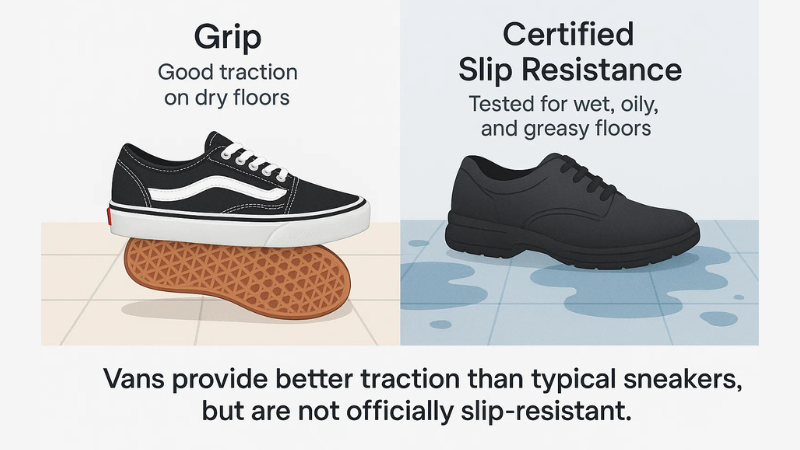
Grip vs. Certified Slip Resistance
It’s important to understand the difference between grip and certified slip resistance:
- Grip:
Vans’ waffle soles create friction, helping prevent slips on normal dry floors.
- Certified slip resistance:
True non-slip or slip-resistant shoes are laboratory tested under wet, oily, and greasy conditions to meet workplace safety standards.
Most Vans models are not marketed as work shoes, so they haven’t undergone official slip-resistance testing. While the soles feel grippy in daily use, they may not meet safety requirements for environments like hospitals, kitchens, or restaurants.
Bottom Line for Nurses and Workers
Vans provide better traction than typical fashion sneakers, but they do not carry an official slip-resistant certification. For professionals who spend long hours on slick or wet floors, relying solely on Vans may not be enough to prevent slips or workplace accidents.
For safer alternatives, see Best Shoes for Nurses.
2. Are Vans Shoes Good for Work in Hospitals?
Vans are a popular choice among many healthcare workers thanks to their lightweight design, affordability, and casual style. Their flat, cushioned sole provides moderate comfort for walking between wards, and the simple slip-on or lace-up designs make them easy to put on and take off during busy shifts.
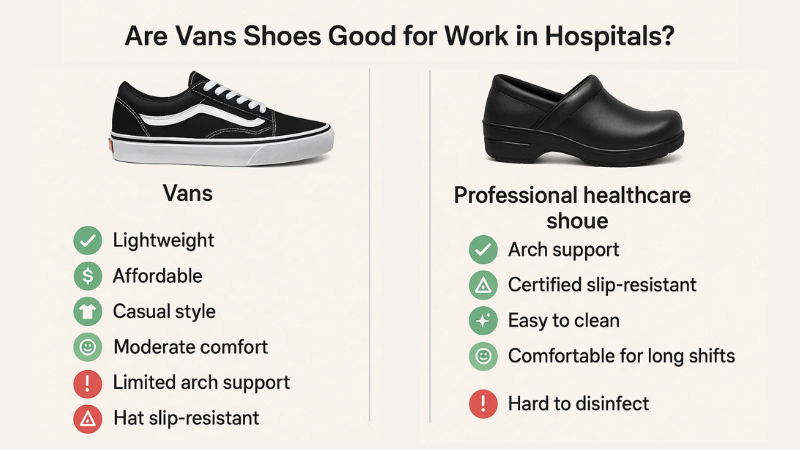
Limitations for Long Shifts
While Vans are comfortable for short periods, they aren’t specifically engineered for long hospital shifts or clinical environments:
- Arch support and shock absorption:
Vans typically lack the structured support that nursing clogs or professional healthcare shoes offer, which can lead to fatigue over 8–12 hours on your feet.
- Slip-resistant performance:
Their waffle-pattern sole provides some grip, but it does not have certified slip-resistant testing. On wet or polished floors, this could pose a safety risk.
- Hygiene considerations:
Traditional Vans often use canvas or suede uppers, which can be harder to clean and disinfect compared with smooth leather or synthetic materials designed for medical environments.
Practical Advice for Nurses
For short shifts or light-duty tasks, Vans may be acceptable.
For full hospital shifts, long-standing comfort, hygiene, and safety are better served by shoes specifically made for healthcare, such as Dansko, Skechers Work, or Crocs nursing shoes.
Key Takeaway
Vans can work in a hospital setting for casual comfort or short duties, but for extended shifts and high-traffic clinical areas, certified healthcare shoes offer better support, hygiene, and slip-resistant protection.
3. Vans vs Non-Slip Work Shoes: What Nurses and Workers Should Know
At first glance, Vans can seem like a convenient choice for busy workplaces. They’re affordable, lightweight, and stylish, and their iconic waffle sole provides decent grip for everyday walking.
But it’s important to understand the difference between good traction for casual wear and certified slip resistance designed for professional settings.
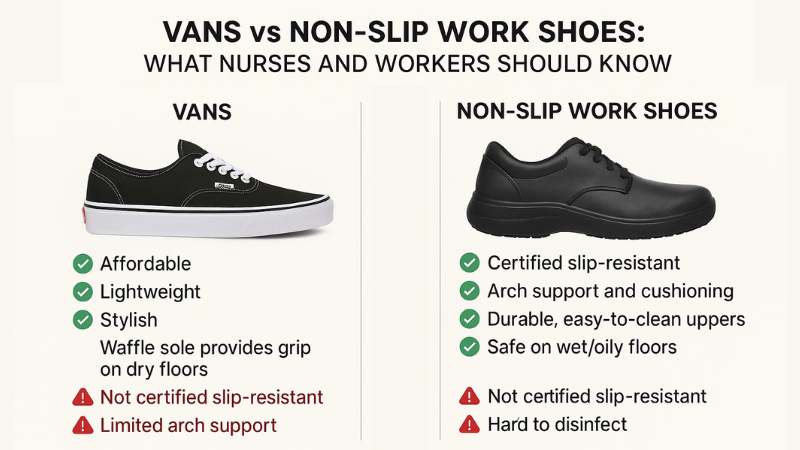
Certified Non-Slip Work Shoes
Professional slip-resistant shoes, such as those from Skechers Work, Crocs Pro, or Dansko, are laboratory tested to meet safety standards under oil, grease, and wet conditions. They also offer:
- Arch support and cushioning:
Reduces fatigue during long shifts and provides comfort for hours on your feet. Especially if you have flat fleet, you need good arch support the most.
Confused about which shoes to get? Don’t worry, we’ve brought to you the best shoes for flat feet so that you can be at your best when it’s duty time.
- Durable, easy-to-clean uppers:
Materials like leather or synthetic surfaces can be disinfected easily, which is crucial in hospitals or kitchens.
- Slip-resistant soles:
Engineered to maintain traction on slick floors, giving you confidence and safety in demanding environments.
Choosing Between Vans and Non-Slip Shoes
- Short shifts or light-duty work:
Vans may be acceptable for casual use or tasks on dry floors.
- Long shifts or high-risk environments:
For nurses, restaurant staff, or retail workers dealing with spills or polished floors, certified non-slip shoes are a safer, more supportive choice.
Key Takeaway
While Vans are comfortable and stylish for casual wear, they cannot replace professional slip-resistant footwear in environments where floor safety and long-term foot support are critical. Investing in certified non-slip shoes ensures protection, comfort, and confidence during every shift.
4. Can You Wear Vans for Nursing Shifts?
Many nurses and healthcare staff do wear Vans, especially for shorter or lighter shifts. Their flat, cushioned sole and casual style make them easy to slip on, and they are often more affordable than specialized nursing shoes.
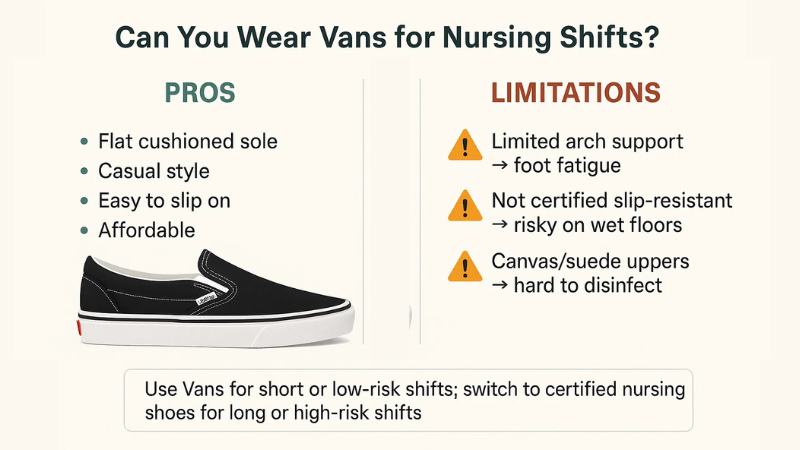
Limitations for Long or High-Risk Shifts
While Vans may be convenient, they have several drawbacks for full nursing shifts:
- Arch support:
Vans lack structured support, which can lead to foot fatigue over long hours on your feet.
- Slip resistance:
They are not certified slip-resistant, making them less reliable on wet or polished hospital floors.
- Sanitation:
Canvas or suede uppers are harder to disinfect compared with smooth leather or synthetic nursing shoes.
Practical Tips
- For short shifts or low-risk tasks, Vans can work as a comfortable, casual option.
- For 12-hour shifts or environments with frequent spills, it’s safer to wear nursing-specific shoes that offer arch support, slip resistance, and easy-to-clean materials.
If you love the Vans style, consider keeping a pair for casual wear and switching to certified work shoes for high-risk areas or longer shifts.
Key Takeaway
Vans can be worn for nursing in certain situations, but for maximum safety, support, and hygiene, professional nursing footwear is a better choice.
5. Are Vans OSHA Approved Non Slip Shoes?
If you’re wondering whether Vans are OSHA-approved non slip shoes, it’s important to understand how OSHA regulates workplace footwear.
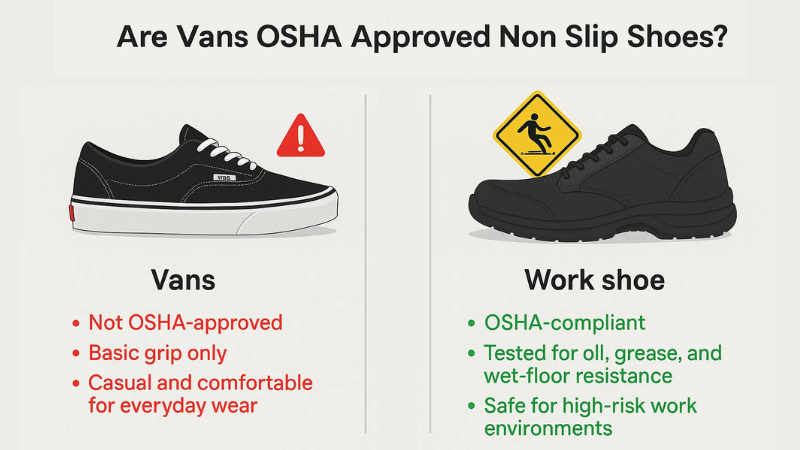
OSHA’s Role
OSHA (Occupational Safety and Health Administration) does not approve or certify specific brands of shoes.
Instead, OSHA sets workplace safety standards and expects employers to ensure that staff wear footwear that meets slip-resistant requirements for their specific environment.
Vans and OSHA Compliance
Vans are not officially OSHA-approved as non-slip or safety shoes.
While the waffle-pattern sole provides basic grip, Vans have not been tested under OSHA safety standards for oil, grease, or wet-floor resistance like certified work shoes.
What Nurses and Workers Should Do
If your employer requires OSHA-compliant footwear, you’ll need professional slip-resistant shoes that clearly state they meet safety standards.
Vans can be stylish and comfortable for casual wear, but they cannot replace certified safety shoes in workplaces with strict slip-resistance requirements.
Key Takeaway
Vans are not OSHA-approved and should not be relied on for official workplace safety in environments with slippery floors. For long shifts or high-risk areas, invest in certified slip-resistant shoes to ensure both compliance and safety.
Best Alternatives to Vans for Healthcare Workers
While Vans are stylish and comfortable for casual use, they aren’t ideal for long hospital shifts or environments where slip-resistance, support, and hygiene are critical. If you want shoes that combine comfort, safety, and professional performance, consider these alternatives:
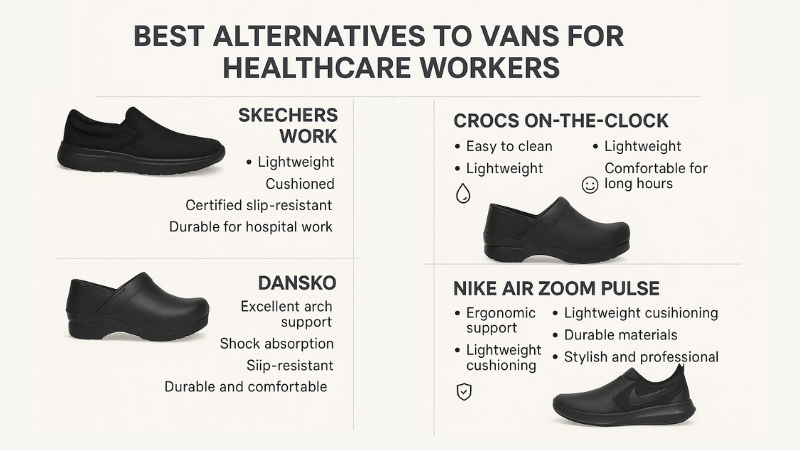
1. Skechers Work
- Lightweight and cushioned, reducing fatigue during long shifts.
- Certified slip-resistant soles provide reliable traction on wet or oily floors.
- Durable design suitable for fast-paced hospital or clinical environments.
2. Crocs On-The-Clock
- Easy to clean and sanitize, making them perfect for healthcare settings.
- Durable and lightweight, offering comfort for long hours on your feet.
- Designed specifically for hospital and nursing environments, combining safety with convenience.
3. Dansko
- Offers excellent arch support and shock absorption, reducing foot and back fatigue.
- Professional clogs are slip-resistant and easy to clean, ideal for long nursing shifts.
- Known for durability and comfort, trusted by healthcare workers worldwide.
4. Nike Air Zoom Pulse
- Modern design with ergonomic support tailored for long periods of standing and walking.
- Lightweight cushioning combined with durable materials.
- Balances style, comfort, and professional performance, making it a great option for nurses who want both support and aesthetic appeal.
Why These Alternatives Are Better Than Vans
These shoes are built with healthcare safety standards in mind, providing:
- Better traction on slick hospital floors
- Enhanced arch support and cushioning for long shifts
- Durable, easy-to-clean materials, important for hygiene and infection control
Key Takeaway
For healthcare workers, investing in shoes designed for long shifts, slip-resistance, and foot support is crucial. While Vans may work for casual use, brands like Skechers Work, Crocs On-The-Clock, Dansko, and Nike Air Zoom Pulse offer reliable safety and comfort without compromising style.
Conclusion
So, are Vans non slip? The short answer: not officially. Vans’ waffle soles provide decent everyday traction, but they aren’t certified non-slip or OSHA-approved for workplaces with wet or oily floors.
For nurses, restaurant staff, and other workers spending long hours on their feet, specialized non-slip shoes are a safer choice. Options like Skechers Work, Crocs On-The-Clock, Dansko, or Nike Air Zoom Pulse offer better arch support, certified traction, and easier cleaning for professional settings.
FAQs About Vans and Slip Resistance
Do Vans count as non-slip shoes?
Vans offer decent grip with their waffle soles, but they are not officially slip-resistant or tested for professional workplace safety.
Can Vans be used in restaurants or hospitals?
Some people wear Vans in these environments for short shifts, but long hours or slippery floors require certified non-slip shoes.
What makes a shoe OSHA approved?
OSHA doesn’t certify specific brands. Shoes must meet slip-resistant standards set by OSHA and your employer to be considered compliant.
Are Vans good for standing all day?
While Vans are cushioned, they lack proper arch support and shock absorption, making them less ideal for long hospital or restaurant shifts.
Which Vans model is best for grip?
All Vans share a waffle-pattern sole, but none are lab-tested for oil or wet surfaces. For true workplace safety, it’s better to choose certified non-slip shoes instead.

Leave a Reply